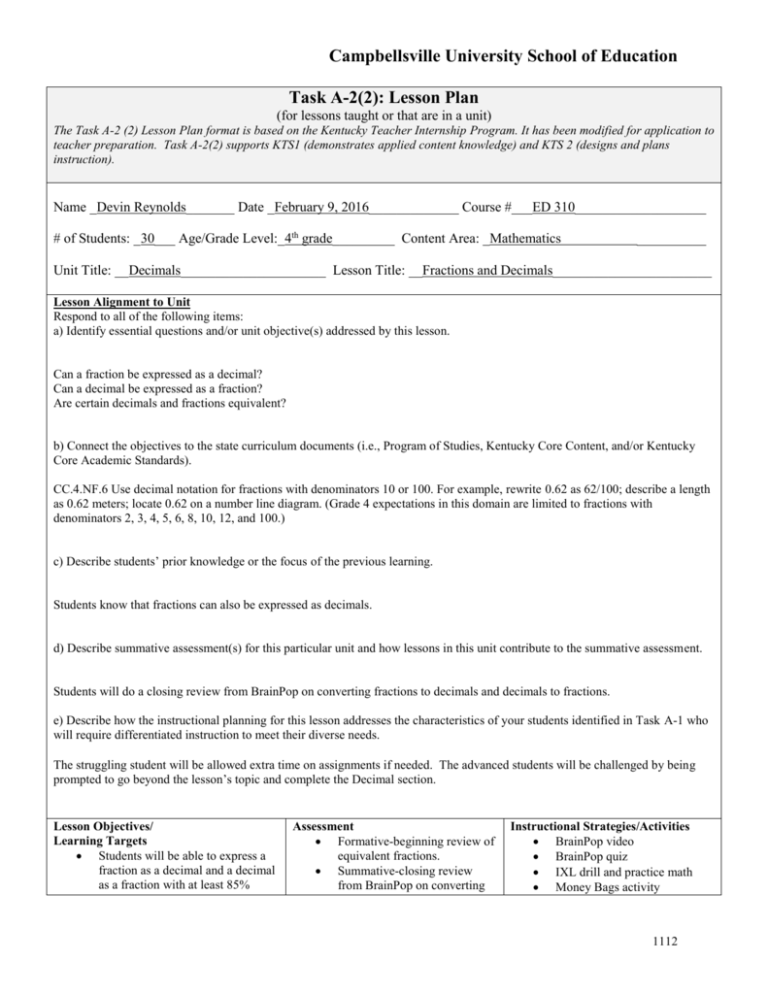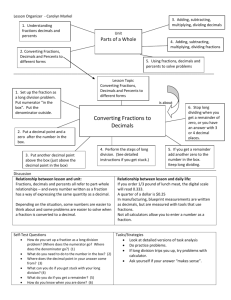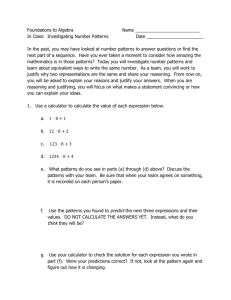Fractions and Decimals A2
advertisement

Campbellsville University School of Education Task A-2(2): Lesson Plan (for lessons taught or that are in a unit) The Task A-2 (2) Lesson Plan format is based on the Kentucky Teacher Internship Program. It has been modified for application to teacher preparation. Task A-2(2) supports KTS1 (demonstrates applied content knowledge) and KTS 2 (designs and plans instruction). Name _Devin Reynolds_______ Date _February 9, 2016_____________ Course #___ED 310___________________ # of Students: _30___ Age/Grade Level:_4th grade_________ Content Area: _Mathematics __________ Unit Title: __Decimals_____________________ Lesson Title: __Fractions and Decimals_______________________ Lesson Alignment to Unit Respond to all of the following items: a) Identify essential questions and/or unit objective(s) addressed by this lesson. Can a fraction be expressed as a decimal? Can a decimal be expressed as a fraction? Are certain decimals and fractions equivalent? b) Connect the objectives to the state curriculum documents (i.e., Program of Studies, Kentucky Core Content, and/or Kentucky Core Academic Standards). CC.4.NF.6 Use decimal notation for fractions with denominators 10 or 100. For example, rewrite 0.62 as 62/100; describe a length as 0.62 meters; locate 0.62 on a number line diagram. (Grade 4 expectations in this domain are limited to fractions with denominators 2, 3, 4, 5, 6, 8, 10, 12, and 100.) c) Describe students’ prior knowledge or the focus of the previous learning. Students know that fractions can also be expressed as decimals. d) Describe summative assessment(s) for this particular unit and how lessons in this unit contribute to the summative assessment. Students will do a closing review from BrainPop on converting fractions to decimals and decimals to fractions. e) Describe how the instructional planning for this lesson addresses the characteristics of your students identified in Task A-1 who will require differentiated instruction to meet their diverse needs. The struggling student will be allowed extra time on assignments if needed. The advanced students will be challenged by being prompted to go beyond the lesson’s topic and complete the Decimal section. Lesson Objectives/ Learning Targets Students will be able to express a fraction as a decimal and a decimal as a fraction with at least 85% Assessment Formative-beginning review of equivalent fractions. Summative-closing review from BrainPop on converting Instructional Strategies/Activities BrainPop video BrainPop quiz IXL drill and practice math Money Bags activity 1112 Campbellsville University School of Education accuracy. Objective/target: I can express a fraction as a decimal and a decimal as a fraction with at least 85% accuracy. fractions to decimals and decimals to fractions. Formative- Money Bags activity Assessment description: Students will take a summative assessment at the end of the lesson to assess their knowledge grasp of the lesson. This assessment will be electronic. Students will be broken up into groups and asked to count amounts of money and identify its fraction to a dollar. Differentiated Assessment Plan: Students will be given a paper form of the closing summative assessment and allotted extra time if needed. Students will be given their own money bag and complete the task by themselves. Strategy/Activity: Students will complete the Decimal (fractions and decimals) part of IXL. Students will answer opening questions using their page protectors as dry erase boards. Students will complete a Money Bags lab examining a given amount of money in relation to a dollar. Differentiated Strategies/Activities: Struggling students will be grouped and given extra assistance in their completion of IXL. Advanced students will be prompted to complete the entire Decimal section of IXL. Media/Technologies/Resources: Computer—IXL BrainPop video SmartBoard Page protector Computers for each student Money bags Procedures: Describe the sequence of strategies and activities you will use to engage students and accomplish your objectives. Within this sequence, describe how the differentiated strategies will meet individual student needs and diverse learners in your plan. Use this section to outline the who, what, when, and where of the instructional strategies and activities. Include estimated time for each procedure. Beginning Review: I will write these fractions on the board: ½, ¼, and 1/5. Students will then find equivalent fractions of the given fractions with denominators of 10 or 100. I will review with students that finding equivalent fractions is necessary (multiply the numerator and denominator by the same number). This activity prepares students for expressing a fraction as a decimal and vice versa. Students will answer using their page protector white boards that were provided by the teacher earlier in the year. Anticipatory Set: After discussing the opening questions, students will watch the “Converting Fractions to Decimals” video via BrainPop. The video gives many examples of converting fractions to decimals and vice versa. Concept Development: Students will complete the “Money Bags” activity and be put into groups of 3 or 4. There will be 10 ziploc bags around the room and students will rotate to each bag and count the coins in the bag. A chart will be provided for the students to record their money as a decimal and what fraction of a dollar the money in their bag is. Each bag will have a random, different amount of coins in it. Guided Practice: I will have students log onto IXL math (www.ixl.com) and we will complete a question from the Decimals section (topic T.6-Converting Fractions and mixed numbers to decimals and T.7-Converting decimals to fractions and mixed numbers) as a class. The students will complete the rest of the Decimals section on their own. Independent Practice: 1112 Campbellsville University School of Education As students are completing their decimal questions, I will be walking around the room supervising. However, the students will largely be left to themselves to complete this section to determine whether or not they have learned the content. Ending Review: To close out the lesson, the students will take a summative assessment over fractions and decimals provided by BrainPop Jr. They will take the quiz using iClickers. 1112 Campbellsville University School of Education ADDENDUM TO TASK A-2 IMPORTANT: The Following Chart Is To Be completed Only If This Lesson Is Taught In A Classroom And Pre-Post Assessments Are conducted. The addendum must be completed prior to the completion of Task A-2. Pre-Assessment Analysis Describe the patterns of student performance you found relative to each objective. Attach tables, graphs or charts of student performance that allowed you to identify the patterns of student performance noted. Describe how you used the analysis of your pre-assessment data in your design of instruction. How did your awareness of achievement gap groups within your students influence your planning and instruction? 1112







